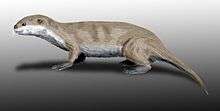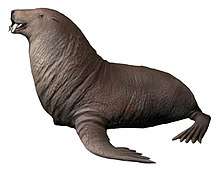South American sea lion
The South American sea lion (Otaria flavescens, formerly Otaria byronia), also called the Southern Sea Lion and the Patagonian sea lion, is a sea lion found on the Ecuadorian, Peruvian, Chilean, Falkland Islands, Argentinean, Uruguayan, and Southern Brazilian coasts. It is the only member of the genus Otaria. Its scientific name was subject to controversy, with some taxonomists referring to it as Otaria flavescens and others referring to it as Otaria byronia. The former eventually won out,[3] although that may still be overturned.[4] Locally, it is known by several names, most commonly lobo marino (es)/lobo marinho (pt) (sea wolf) and león marino (es)/leão marinho (pt) (sea lion) and the hair seal.
| South American sea lion | |
|---|---|
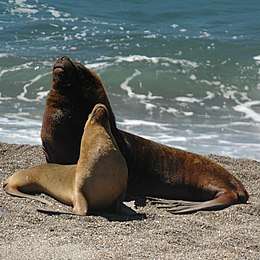 | |
| Male and female | |
| Scientific classification | |
| Kingdom: | Animalia |
| Phylum: | Chordata |
| Class: | Mammalia |
| Order: | Carnivora |
| Clade: | Pinnipediformes |
| Clade: | Pinnipedia |
| Family: | Otariidae |
| Genus: | Otaria Péron, 1816 |
| Species: | O. flavescens |
| Binomial name | |
| Otaria flavescens (Shaw, 1800)[2] | |
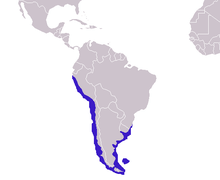 | |
| South American sea lion range | |
| Synonyms | |
|
Otaria bryonia | |
Description
The South American sea lion is perhaps the archetypal sea lion in appearance. Males have a very large head with a well-developed mane, making them the most lionesque of the eared seals. They are twice the weight of females.[5] Both males and females are orange or brown coloured with upturned snouts. Pups are born greyish orange ventrally and black dorsally and moult into a more chocolate colour.
The South American sea lion's size and weight can vary considerably. Adult males can grow over 2.73 m (9 ft) and weigh up to 350 kg (770 lb).[6] Adult females grow up to 1.8–2 m (6–7 ft) and weigh about half the weight of the males, around 150 kg (330 lb). This species is even more sexually dimorphic than the other sea lions.[7]
Ecology
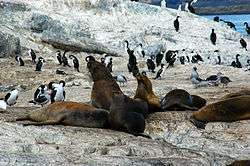
The South American sea lion is found along the coasts and offshore islands of South America, from Peru south to Chile in the Pacific and then north to southern Brazil in the Atlantic.[8] Notable breeding colonies include Lobos Island, Uruguay; Peninsula Valdes, Argentina; Beagle Channel, and the Falkland Islands. Some individuals wander as far north as southern Ecuador, although apparently they never bred there. However, the movement ecology of South American sea lions remains poorly understood, although biologging studies in recent years have advanced our understanding of their at-sea movements at some breeding locations.[9][10][11][12] There is no evidence of a winter migration of sea lions from the Falkland Islands.[13]
South American sea lions breed on beaches made of sand, gravel, rocky, or pebble beaches[8] They can also be seen on flat, rocky cliffs with tidepools.[8] Sea lion colonies tend to be small and scattered, especially on rocky beaches.[8] The colonies make spaces between each individual when the weather is warm and sunny.[8] They can also be found in marinas and wharves, but do not breed there.
South American sea lions consume numerous species of fishes, including Argentine hake and anchovies.[8] They also eat cephalopods, such as shortfin squid, Patagonian squid, and octopus.[8] They have even been observed preying on penguins, pelicans, and young South American fur seals.[14] South American sea lions may forage at the ocean floor for slow-moving prey or hunt schooling prey in groups, depending on the area. When captured, the prey is shaken violently and torn apart. South American sea lions have been recorded to take advantage of the hunting efforts of dusky dolphins, feeding on the fish they herd together.[15] The sea lions themselves are preyed on by killer whales and sharks, and visited as a handy source of blood by common vampire bats from Isla Pan de Azúcar.[16]
Social behavior and reproduction
_(Peninsula_de_Valdes%2C_Jan_1984).jpg)
Mating occurs between August and December, and the pups are born between December and February. Males arrive first to establish and defend territories, but then switch to defending females when they arrive.[7] A male aggressively herds females in his territory and defends from both neighbors and intruders.[7] On rocky beaches, males establish territories where females go to cool off, keeping them until estrus.[8] On cobble or sandy beaches, males have territories near the surf and monopolize females trying to get access to the sea.[8] The number of actual fights between males depends on the number of females in heat.[7] The earlier a male arrives at the site, the longer his tenure will be and the more copulations he will achieve.[7] Males are usually able to keep around three females in their harems, but some have as many as 18.[7]
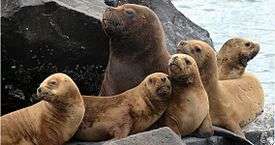
During the breeding season, males that fail to secure territories and harems, most often subadults, will cause group raids in an attempt to change the status quo and gain access to the females.[17] Group raids are more common on sandy beaches than rocky ones.[17] These raids cause chaos in the breeding harems, often splitting mothers from their young. The resident males try to fight off the raiders and keep all the females in their territorial boundaries. Raiders are often unsuccessful in securing a female, but some are able to capture some females or even stay in the breeding area with one or more females.[17] Sometimes, an invading male abducts pups, possibly as an attempt to control the females.[17] They also take pups as substitutes for mature females.[18] Subadults herd their captured pups and prevent them from escaping, much like adult males do to females.[18] A pup may be mounted by its abductor, but intromission does not occur.[18] While abducting pups does not give males immediate reproductive benefits, these males may gain experience in controlling females.[18] Pups are sometimes severely injured or killed during abductions.[17][18]
Despite being mostly a harem-territorial species, one population in Peru has been recorded having a lek-like breeding system. Here, with its longer ratio of males in comparison to females, the males cluster together and display and try to attract females while allowing then to move freely. The warmer climate also makes the females move constantly to the water, further making the traditional mating system difficult to maintain. The group raids that exist in temperate populations are virtually non-existent here.[19]

Sea lion mothers remain with their newborn pups for nearly a week before making a routine of taking three-day foraging trips and coming back to nurse the pups.[7][8] They act aggressively to other females that come close to their pups, as well as alien pups that try to get milk from them.[20] Pups first enter the water at about four weeks and are weaned at about 12 months. This is normally when the mother gives birth to a new pup. Pups gradually spend more time in the nearshore surf and develop swimming skills.[8]
South American sea lions are observed to make various vocalizations and calls which differ between sexes and ages.[21] Adult males make high-pitched calls during aggressive interactions,[21] barks when establishing territories,[21] growls when interacting with females,[21] and exhalations after antagonistic encounters.[21] Females with pups make a mother primary call when interacting with their pups,[21] and grunts during aggressive encounters with other females.[21] Pups make pup primary calls.[21] Some of those vocalizations and acoustic features may support individuality.[21]
Human interactions
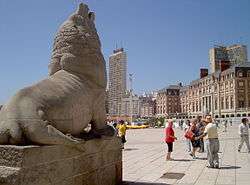
_fur_skin%2C_coloured.jpg)
The Moche people of ancient Peru worshipped the sea and its animals. They often depicted South American sea lions in their art.[22] Two statues of this species are the symbol of the city of Mar del Plata.
Indigenous peoples of South America exploited this species for millennia and by Europeans around the 16th century.[23] The hunting has since gone down and the species is no longer threatened. The species is protected in most of its range.[1] Numerous reserves and protected areas at rookeries and haul-out sites exist for the sea lions.[1] Despite this, protection regulations are not effectively enforced in much of animals' range.[1]
The overall population of sea lions is considered stable; the estimate is 265,000 animals. They are declining in the Falkland Islands, and in Argentina Patagonia, but are increasing in Chile and Uruguay.[1] Many sea lions of the Peruvian population died in the 1997/1998 el Niño.[1][24] They still are killed due to their habits of stealing fish and damaging fishing nets.[1] Sea lions in the port of Mar del Plata have been found with toxic chemicals and heavy metals in their systems.[25]
This species is sometimes kept in captivity.
See also
References
- Campagna, C. (2008). "Otaria flavescens". IUCN Red List of Threatened Species. 2008. Retrieved 30 January 2009.CS1 maint: ref=harv (link)
- Shaw, George (1800). "Yellow seal". General Zoology. Vol. 1. Part 2. Mammalia. London: G. Kearsley. pp. 260–261.
- Rodriguez, D., R. Bastida. 1993. The southern sea lion, Otaria byronia or Otaria flavescens?. Marine Mammal Science, 9(4): 372–381.
- Berta, A. & Churchill, M. (2012). "Pinniped Taxonomy: evidence for species and subspecies". Mammal Review. 42 (3): 207–234. doi:10.1111/j.1365-2907.2011.00193.x.
- Kindersley, Dorling (2001,2005). Animal. New York City: DK Publishing. ISBN 0-7894-7764-5. Check date values in:
|year=(help) - http://www.theanimalfiles.com/mammals/seals_sea_lions/south_american_sea_lion.html
- Campagna, C., B. Le Boeuf. 1988. "Reproductive behavior of southern sea lions". Behaviour, 104(3–4): 233–261.
- Randall R. Reeves; Brent S. Stewart; Phillip J. Clapham; James A. Powell (2002). National Audubon Society Guide to Marine Mammals of the World. Alfred A. Knopf, Inc. ISBN 0375411410.
- Riet-Sapriza FG, Costa DP, Franco-Trecu V et al (2013) Foraging behavior of lactating South American sea lions (Otaria flavescens) and spatial–temporal resource overlap with the Uruguayan fisheries. Deep Sea Res Part II 88–89:106–119.
- Rodríguez DH, Dassis M, Ponce de León A et al (2013) Foraging strategies of Southern sea lion females in the La Plata River Estuary (Argentina–Uruguay). Deep Sea Res Part II 88–89:120– 130.
- Baylis, Alastair M. M.; Orben, Rachael A.; Costa, Daniel P.; Tierney, Megan; Brickle, Paul; Staniland, Iain J. (2017). "Habitat use and spatial fidelity of male South American sea lions during the nonbreeding period". Ecology and Evolution. 7 (11): 3992–4002. doi:10.1002/ece3.2972. PMC 5468127. PMID 28616194.
- Baylis, A.M.M., Orben, R.A., et al. Diving deeper into individual foraging specializations of a large marine predator, the southern sea lion Oecologia (2015) 179: 1053.
- Baylis AMM, Orben RA, Arnould JPY, Christiansen F, Hays GC, Staniland IJ (2015) Disentangling the cause of a catastrophic population decline in a large marine mammal. Ecology 96: 2834–2847.
- Harcourt, R (1993). "Individual variation in predation on fur seals by southern sea lions (Otaria byronia) in Peru". Canadian Journal of Zoology. 71 (9): 1908–1911. doi:10.1139/z93-273.
- Würsig, B. and Würsig, M. 1980. "Behavior and ecology of the dusky dolphin, Lagenorhynchus obscurus, in the South Atlantic". Fishery Bulletin 77: 871–890.
- Midgley, Neil (27 July 2012). "The Dark: Nature's Night-time World, BBC Two, 9.00pm, preview". The Telegraph. Retrieved 12 May 2019.
- Campagna, C., B. Le Boeuf, H. Capposso. 1988. "Group raids: a mating strategy of male southern sea lions". Behaviour, 105(3–4): 224–249.
- Campagna, C., B. Le Boeuf, H. Cappozzo. 1988. "Pup abduction and infanticide in southern sea lions". Behaviour, 107(1–2): 44–60.
- Soto, K. H.; Trites, A. W. (2011). "South American sea lions in Peru have a lek-like mating system". Marine Mammal Science. 27 (2): 306–333. doi:10.1111/j.1748-7692.2010.00405.x.
- Esteban Fernández-Juricic and Marcelo H. Cassini. "Intra-sexual female agonistic behaviour of the South American sea lion (Otaria flavescens) in two colonies with different breeding substrates". Acta Ethologica, Volume 10, Number 1, 23–28, doi:10.1007/s10211-006-0024-4. (2007)
- Esteban Fernández-Juricic, Claudio Campagna, Víctor Enriquez and Charles Leo Ortiz "Vocal Communication and Individual Variation in Breeding South American Sea Lions". Behaviour, Vol. 136, No. 4 (May, 1999), pp. 495–517
- Berrin, Katherine & Larco Museum. The Spirit of Ancient Peru:Treasures from the Museo Arqueológico Rafael Larco Herrera. New York: Thames and Hudson, 1997.
- Rodriguez, D. and Bastida, R. 1998. "Four hundred years in the history of pinniped colonies around Mar del Plata, Argentina". Aquatic Conservation of Marine and Freshwater Ecosystems 8: 721–735.
- Baylis, A. M. M., Orben, R. A., Arnould, J. P. Y., Christiansen, F., Hays, G. C. and Staniland, I. J. (2015), Disentangling the cause of a catastrophic population decline in a large marine mammal. Ecology, 96: 2834–2847. doi:10.1890/14-1948.1.
- Sepulveda, M., M. Alvarado-Rybak, C. Verdugo, E. Quiroz, C. Valencia, C. Munoz-Zanzi, R. Tamayo. Pathogens and heavy metals in Southern sea lions (Otaria flavescens) in Valdivia city, Chile. Arch Med Vet. In review.

